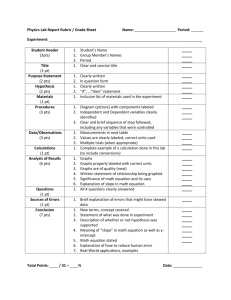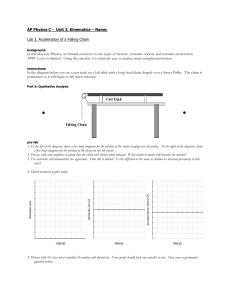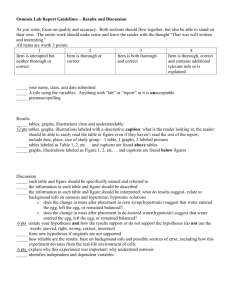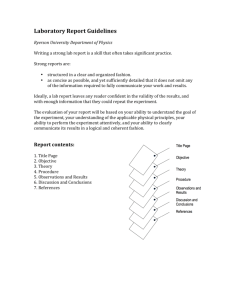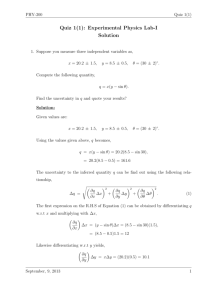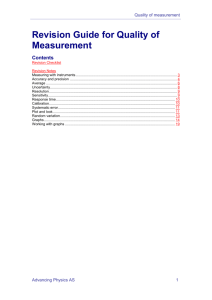Guidelines for Physics Lab Reports:
advertisement
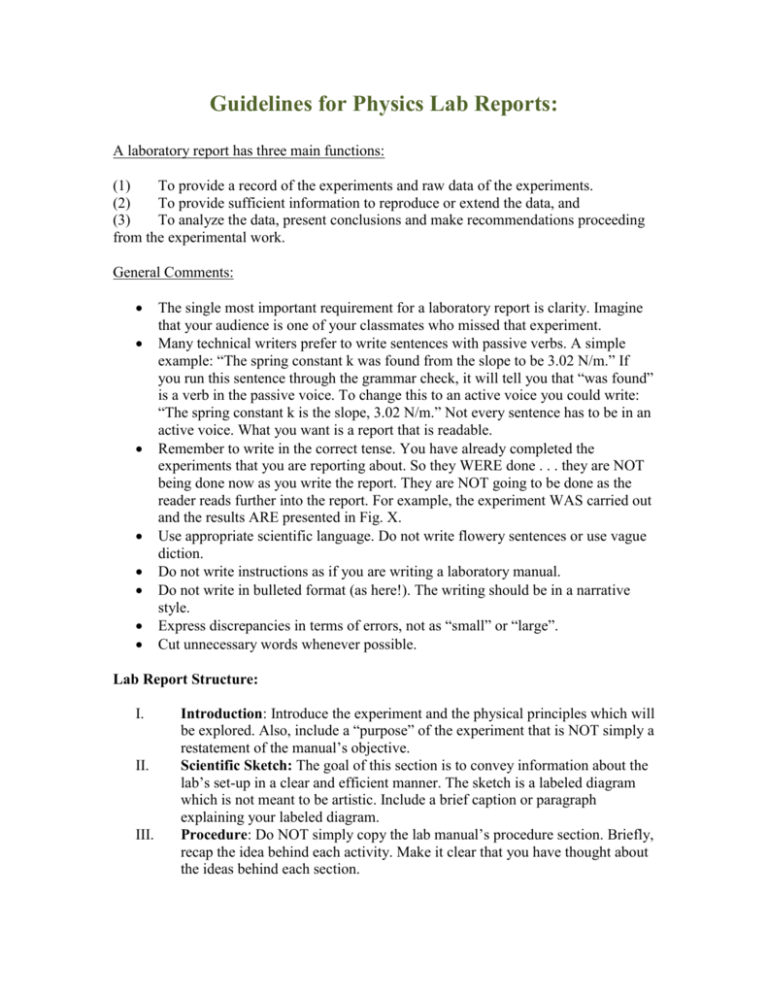
Guidelines for Physics Lab Reports: A laboratory report has three main functions: (1) To provide a record of the experiments and raw data of the experiments. (2) To provide sufficient information to reproduce or extend the data, and (3) To analyze the data, present conclusions and make recommendations proceeding from the experimental work. General Comments: The single most important requirement for a laboratory report is clarity. Imagine that your audience is one of your classmates who missed that experiment. Many technical writers prefer to write sentences with passive verbs. A simple example: “The spring constant k was found from the slope to be 3.02 N/m.” If you run this sentence through the grammar check, it will tell you that “was found” is a verb in the passive voice. To change this to an active voice you could write: “The spring constant k is the slope, 3.02 N/m.” Not every sentence has to be in an active voice. What you want is a report that is readable. Remember to write in the correct tense. You have already completed the experiments that you are reporting about. So they WERE done . . . they are NOT being done now as you write the report. They are NOT going to be done as the reader reads further into the report. For example, the experiment WAS carried out and the results ARE presented in Fig. X. Use appropriate scientific language. Do not write flowery sentences or use vague diction. Do not write instructions as if you are writing a laboratory manual. Do not write in bulleted format (as here!). The writing should be in a narrative style. Express discrepancies in terms of errors, not as “small” or “large”. Cut unnecessary words whenever possible. Lab Report Structure: I. II. III. Introduction: Introduce the experiment and the physical principles which will be explored. Also, include a “purpose” of the experiment that is NOT simply a restatement of the manual’s objective. Scientific Sketch: The goal of this section is to convey information about the lab’s set-up in a clear and efficient manner. The sketch is a labeled diagram which is not meant to be artistic. Include a brief caption or paragraph explaining your labeled diagram. Procedure: Do NOT simply copy the lab manual’s procedure section. Briefly, recap the idea behind each activity. Make it clear that you have thought about the ideas behind each section. IV. V. VI. Data Sheets: For each experiment, the lab manual has one or more data sheets/tables for recording raw data, as well as, intermediate and final data values. These are not for doodling, but for recording your data. If there is a mistake, then draw a single line through that value. a. The values that you record on your data sheet must have: i. Units (such as kg for kilograms) ii. Reasonable uncertainty estimates for given instruments and procedures iii. Precision consistent with the uncertainty (proper significant digits) iv. Propagation of error for calculated quantities Graphs: Must be labeled and have captions explaining the graph. A reader should be able to see the figure and understand what he is seeing. Include units when necessary. The text should contain a reference to the graphs which are numbered appropriately. Discussion of Results: This is the most important part of the lab report; it is where you analyze the data. Regardless of your discipline, the most challenging and rewarding part of your work will be analyzing the data.). Begin the discussion by briefly summarizing the basic idea of the experiment with emphasis on the measurements you made and transition to discussing the results. State only the key results (with uncertainty and units) quantitatively with numerical values; do not provide intermediate quantities. Your discussion should address questions such as: What is the relationship between your measurements and your final results? What trends were observable? What can you conclude from the graphs that you made? How did the independent variables affect the dependent variables? (For example, did an increase in a given measured (independent) variable result in an increase or decrease in the associated calculated (dependent) variable?) Then describe how your experimental results substantiate/agree with the theory. (This is not a single statement that your results agree or disagree with theory.) When comparison values are available, discuss the agreement using either uncertainty and/or percent differences. This leads into the discussion of the sources of error. In your discussion of sources of error, you should discuss all those things that affect your measurement, but which you can't do anything about given the time and equipment constraints of this laboratory. Included in this would be a description of sources of error in your measurement that bias your result (e.g. friction in pulleys that are assumed frictionless. Your analysis should describe the qualitative effect of each source of error (e.g. friction slowed motion, causing a smaller value of acceleration to be measured) and, where possible, provide an estimate of the magnitude of the errors they could induce. Describe only the prominent sources of error in the experiment. For example, the precision of the triple balance beam, a fraction of a gram, compared to the 250.0 g lab cart is not significant. Note that a tabulation of all possible errors without any discussion of qualitative effect of the error will receive no credit. Your discussion should address questions such as: VII. Are the deviations due to error/uncertainty in the experimental method, or are they due to idealizations inherent in the theory (or both)? If the deviations are due to experimental uncertainties, can you think of ways to decrease the amount of uncertainty? If the deviations are due to idealizations in the theory, what factors has the theory neglected to consider? In either case, consider whether your results display systematic or random deviations. Conclusion: This section should not simply restate the objectives and say that you did (or did not) accomplished them. You can summarize the results of the experiment and maybe suggesting ways this experiment or future experiments might be improved or extended. Grading: The point distribution will be as follows: 5 pts: Questions turned in at the end of lab. 5 pts: Introduction, Scientific Sketch, Procedure 5pts: Data, Graphs and Calculations. 5pts: Discussion and Conclusion Total: 20 pts Ed Lamere, Notre Dame – September 2011 Note: This outline is an adapted/hybrid version of a physics lab report guide from Baylor University and the University of Sydney. The originals can be found here: www.baylor.edu/content/services/document.php/110769.pdf www.physics.usyd.edu.au/pdfs/current/sphys/...lab/report_writing.pdf
